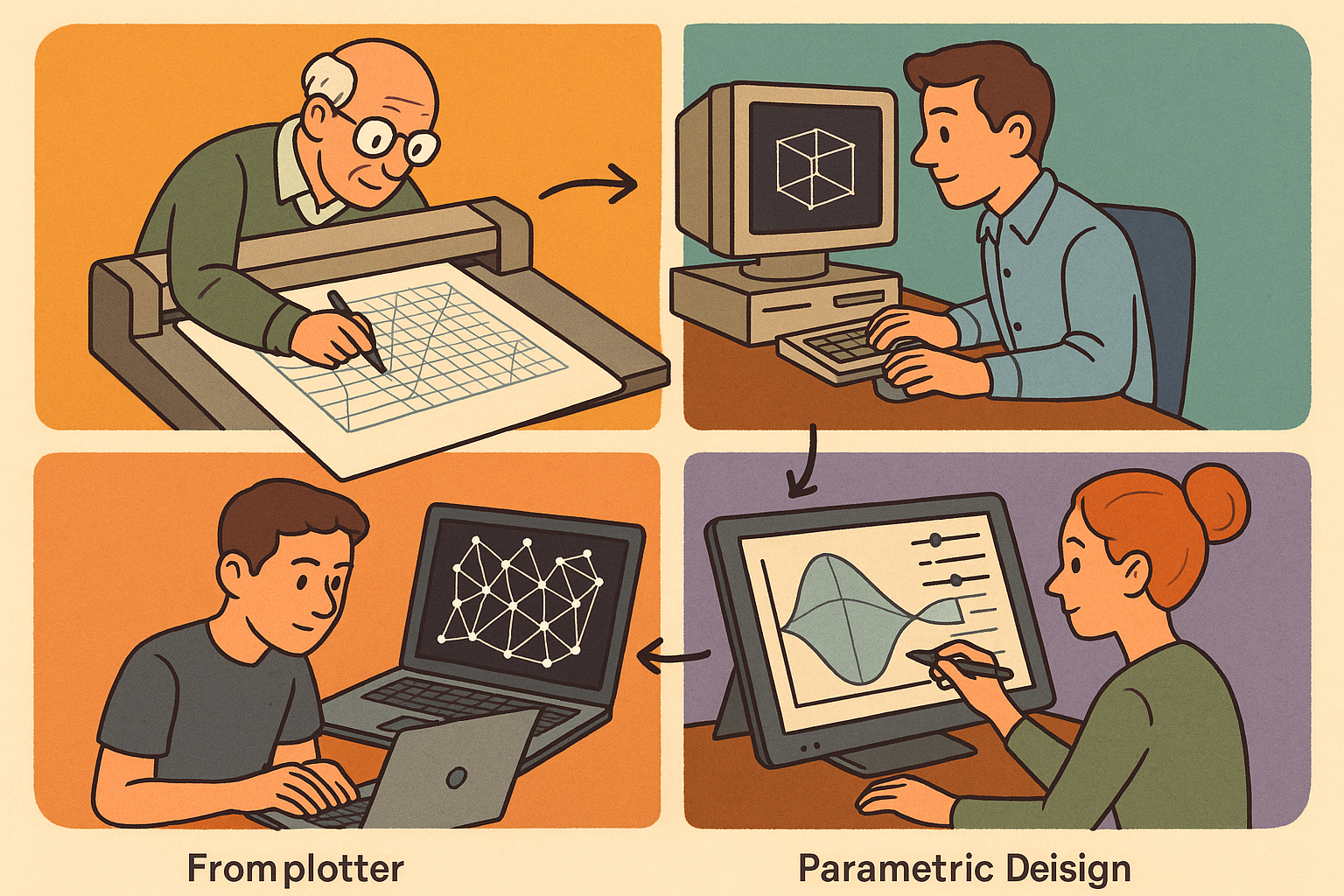Your Cart is Empty
Customer Testimonials
-
"Great customer service. The folks at Novedge were super helpful in navigating a somewhat complicated order including software upgrades and serial numbers in various stages of inactivity. They were friendly and helpful throughout the process.."
Ruben Ruckmark
"Quick & very helpful. We have been using Novedge for years and are very happy with their quick service when we need to make a purchase and excellent support resolving any issues."
Will Woodson
"Scott is the best. He reminds me about subscriptions dates, guides me in the correct direction for updates. He always responds promptly to me. He is literally the reason I continue to work with Novedge and will do so in the future."
Edward Mchugh
"Calvin Lok is “the man”. After my purchase of Sketchup 2021, he called me and provided step-by-step instructions to ease me through difficulties I was having with the setup of my new software."
Mike Borzage
Design Software History: John Walker and Autodesk: Pioneers in the Evolution of CAD Software and Modern Design Practices
September 23, 2024 5 min read


In the realm of modern industrial design, architecture, engineering, and manufacturing, the transformative impact of Computer-Aided Design (CAD) software cannot be overstated. As one of the pioneers in this field, John Walker, alongside Autodesk, has played a vital role in shaping the landscape of design software. This article delves into the profound history and evolution of CAD software, focusing on the pioneering contributions of John Walker and Autodesk.
The Early Days of John Walker and Autodesk
Background on John Walker
John Walker's journey into the world of computing and design began with his deep-seated interests in technology and programming. Born in 1950, Walker pursued an eclectic career path before finding his true calling in the burgeoning field of computer-aided design. His early career saw him dabbling in various facets of computing, laying the groundwork for his future visionary endeavors.
Walker’s inspiration for Autodesk stemmed from a profound belief that personal computing could revolutionize design processes across industries. He envisioned a future where powerful design tools were accessible to professionals and hobbyists alike, democratizing the design landscape. This vision became the driving force behind the creation of Autodesk.
Founding of Autodesk
In 1982, John Walker, along with a team of similarly passionate individuals, founded Autodesk. The initial team consisted of programmers, engineers, and visionaries who collectively aimed to develop a software solution that would become indispensable to designers globally.
The development of AutoCAD, Autodesk’s flagship product, marked the beginning of a new era in design software. However, the journey was far from straightforward. The early stages were fraught with technical challenges, market skepticism, and financial constraints. Nevertheless, Walker and his team’s perseverance paid off, and AutoCAD was officially launched, setting the stage for future innovations in CAD software.
The Development and Evolution of AutoCAD
Technical Innovations
AutoCAD introduced several key features and technological advancements that set it apart from other design software available at the time. Initially a 2D drafting tool, AutoCAD evolved to incorporate 3D modeling capabilities, significantly enhancing its utility across various design and engineering disciplines.
Some of the notable technological advancements introduced by AutoCAD include:
- Layering System: Allowed users to organize and manage complex drawings effectively.
- Block Libraries: Enabled the reuse of common design elements, saving time and effort.
- Parametric Modeling: Facilitated the creation of designs with interdependent components, ensuring consistency and precision.
These features, among others, cemented AutoCAD’s position as a trailblazer in the CAD software market.
Market Impact
The introduction of AutoCAD revolutionized traditional drafting and design processes. Prior to AutoCAD, design professionals relied heavily on manual drafting methods, which were time-consuming and prone to errors. AutoCAD’s digital approach streamlined these processes, enhancing accuracy and efficiency.
AutoCAD’s impact extended across multiple industries, including architecture, engineering, and manufacturing. Its adoption transformed the workflows in these sectors, enabling more intricate and precise designs. Architects could now visualize their concepts in 3D, engineers could simulate structural behaviors, and manufacturers could optimize their production processes.
Influence on Modern Design Practices
Standardization in the Industry
Autodesk’s contributions transcended software development, as it played a pivotal role in setting industry standards for CAD software. The widespread adoption of AutoCAD led to the establishment of standardized practices and conventions in design and drafting. This standardization facilitated smoother collaboration among professionals and organizations, ensuring consistency across projects.
Furthermore, Autodesk championed the cause of interoperability and file format compatibility. Initiatives such as the DWG file format became industry staples, allowing seamless data exchange between different CAD platforms. This focus on interoperability ensured that design data could be shared and utilized across various software environments, enhancing productivity and collaboration.
Integration with Other Technologies
Autodesk’s influence extended beyond CAD, as it played a crucial role in integrating CAD with CAM (Computer-Aided Manufacturing) and CAE (Computer-Aided Engineering) technologies. This integration created a cohesive ecosystem where design, manufacturing, and engineering processes could be interconnected, optimizing workflows and reducing time-to-market.
The impact of this integration was profound:
- Enhanced Productivity: Streamlined workflows minimized redundancies and accelerated project timelines.
- Improved Precision: Integrated systems ensured that design data translated accurately into manufacturing and analysis stages.
- Cost Efficiency: Reduced errors and rework, resulting in significant cost savings for businesses.
Autodesk’s role in fostering these integrations underscored its commitment to advancing the broader field of design and manufacturing.
Legacy and Future Directions
John Walker’s Continued Influence
John Walker’s contributions to the CAD community extended far beyond his tenure at Autodesk. His thought leadership, publications, and ongoing projects continued to shape the discourse around design software and its potential. Walker’s insights into the future of design technology and his advocacy for open-source software highlighted his enduring influence on the industry.
Walker’s legacy is marked by his unwavering commitment to innovation and democratization of technology. His vision of making powerful design tools accessible to all remains a cornerstone of modern CAD practices.
Autodesk’s Ongoing Innovations
Autodesk remains at the forefront of CAD innovation, continually pushing the boundaries of what design software can achieve. Recent advancements have focused on cloud-based CAD solutions, leveraging the power of cloud computing to enhance collaboration, scalability, and accessibility. These solutions enable designers to work from anywhere, access vast computational resources, and collaborate in real-time.
Additionally, Autodesk has been exploring the integration of artificial intelligence (AI) into its software offerings. AI-driven tools can assist designers by automating repetitive tasks, providing intelligent design suggestions, and optimizing workflows. This integration holds the potential to further revolutionize design practices, making them more efficient and intuitive.
Looking forward, Autodesk is poised to continue its legacy of innovation, exploring new frontiers in design technology and empowering professionals across industries to realize their creative visions.
Conclusion
Summary of Key Points
This article has explored the pivotal roles of John Walker and Autodesk in the history and evolution of CAD software. From Walker’s early vision and the founding of Autodesk to the groundbreaking development of AutoCAD and its far-reaching impact, the journey has been marked by technical innovation and market disruption.
Autodesk’s influence on modern design practices, through standardization and integration with other technologies, has left an indelible mark on the industry. The ongoing contributions of John Walker and the continuous innovations by Autodesk underscore the importance of their legacy in shaping the future of design software.
Reflection on Impact
The lasting legacy of Autodesk on modern design practices is a testament to the power of visionary leadership and relentless innovation. The democratization of design tools, the establishment of industry standards, and the seamless integration with manufacturing and engineering workflows have transformed how professionals approach design.
As we look to the future, the importance of continuous innovation in the field of design software cannot be overstated. The advancements pioneered by John Walker and Autodesk serve as a foundation upon which future generations will build, driving the evolution of design technology and empowering creativity across disciplines.
Also in Design News

Design Software History: From Plotters to Procedural Intent: A Technical History of Generative and Parametric Design Software
January 04, 2026 13 min read
Read More
Semantic Meshes: Enabling Analytics-Ready Geometry for Digital Twins
January 04, 2026 12 min read
Read MoreSubscribe
Sign up to get the latest on sales, new releases and more …



